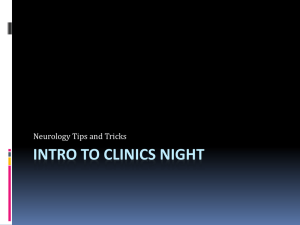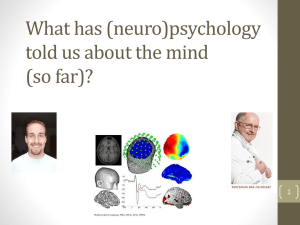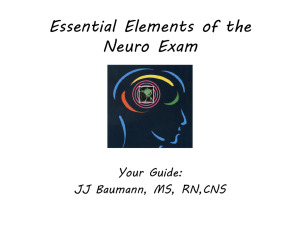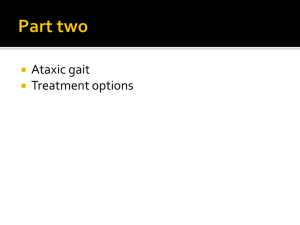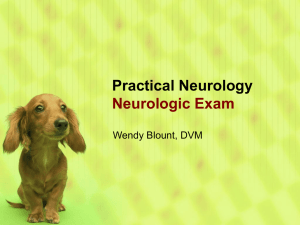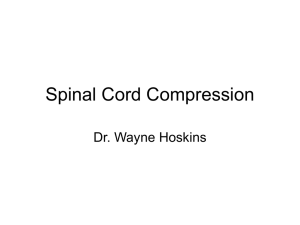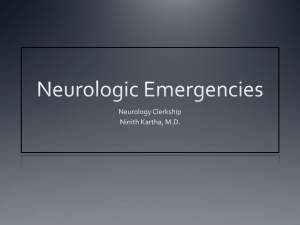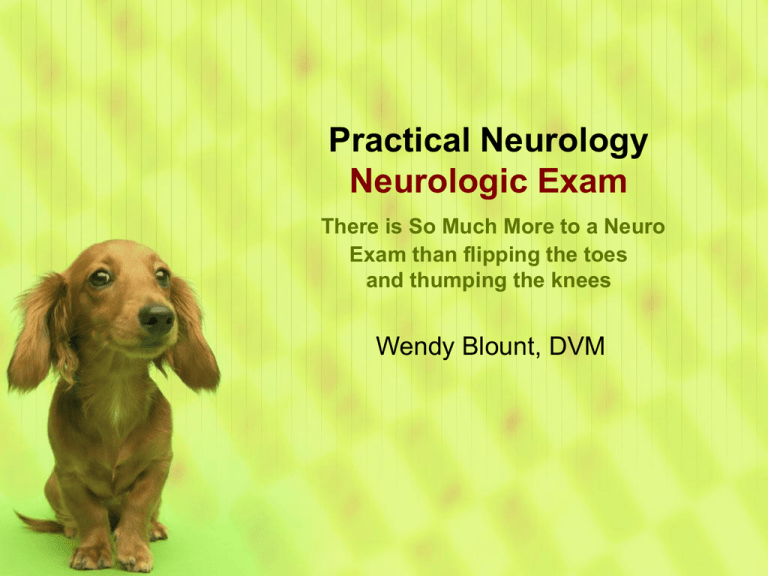
Practical Neurology
Neurologic Exam
There is So Much More to a Neuro
Exam than flipping the toes
and thumping the knees
Wendy Blount, DVM
Definitions – Neurologic System
(2 parts)
Autonomic Nervous System (2 parts)
• Sympathetic
• Parasympathetic
Somatic Nervous System (2 parts)
• Central Nervous System (2 parts)
– Brain (3 parts)
• Forebrain, Brain Stem, Cerebellum
– Spinal Cord (5 parts)
• Cervical, Thoracic Limb, ThoracoLumbar,
Pelvic Limb, SacroCoccygeal
• Peripheral Nerves (2 kinds)
– Cranial Nerves, Spinal Nerves
UMN and LMN??
Definitions – Motor Nerves
Neuron
• nerve cell
UMN – upper motor neuron
• Originate
– from the brain
• Stimulate or inhibit
– the nerves (LMN) that directly control motor
activity
– Initiate movement
– Maintain muscle tone
– Regulate posture
Definitions – Motor Nerves
LMN – lower motor neuron
• Originate
– from the spinal cord
• Directly innervate
– Muscles
– Effector organs
BOTTOM LINE:
UMN tell LMN what to do
LMN tell muscles what to do
Definitions – Motor Nerves
Example - patellar reflex
LMN
• Originate in the LS spinal cord
• Axons run down the rear limb
UMN
• Originate in the brain
• Axons run down the spinal cord to LS
• Synapse on the LMN
Definitions – Motor Nerves
Example - patellar reflex
UMN Lesions
UMN initiate movement, regulate m. tone & posture
• Increased stiffness of muscles, spastic paresis
• Brisk spinal reflexes (3-4)
• Increased stride length
• Conscious Proprioreception (CP) deficits
Lesion in the CNS above tested nerve reflex
• Tested nerve reflex
– LS spinal cord
– Femoral nerve
• Above
– Spinal cord – Cervical, thoracic limb, TL
– Brain
Definitions – Motor Nerves
Example - patellar reflex
LMN Lesion
LMN tell muscles in rear limb what to do
Muscle weakness
• Flaccid weakness
• Weak or absent spinal reflexes (0-1)
• Shortened stride length
• CP deficits
Lesion in the CNS at tested nerve reflex
• LS spinal cord
• Femoral nerve
• Muscles of the leg
Definitions – Neuroanatomy
CNS Part 1 – Forebrain (job?)
Controls behavior, consciousness and
proprioreception (2 parts?)
• Cerebrum and Diencephalon
Which Cranial Nerves originate here?
• CN 1-3
– 1 - O – Olfactory (smell)
– 2 - O – Optic (sight)
– 3 - O – Oculomotor (pupil)
• Indirect effects on CN 5
– 5 - T – Trigeminal (facial sensation)
Definitions – Neuroanatomy
Diencephalon (2 parts?)
Thalamus and Hypothalamus
Hypothalamus
Controls pituitary and other hormones
Appetite and water intake
Thalamus
Sensation
Temperature regulation
Definitions – Neuroanatomy
CNS Part 2 - Brain Stem (job?)
Level of Consciousness and involuntary
vital functions (breathing, etc.) (3 parts?)
• Midbrain, Pons, Medulla
• ARAS – Ascending Reticular Activating
System
Which Cranial Nerves?
• CN 3-12
Level of Consciousness, Posture &
Cranial Nerves (except eyes & smell)
assess the brain stem
Definitions – Neuroanatomy
Cranial Nerves
O - On
O - Old
O - Olympus’s
T - Towering
T - Top
A-A
F - Fat
V - Vicous
G - Goat
V - Vandalized
A-A
H - Hat
(Pnemonic)
1 - Olfactory
2 - Optic
3 - Oculomotor
4 - Trochlear
5 - Trigeminal
6 - Abducens
7 - Facial
8 - Vestibulocochlear
9 - Glossopharyngeal
10 - Vagus
11 - Accessory
12 - Hypoglossal
Definitions – Neuroanatomy
CNS Part 3 – Cerebellum (job?)
Controls muscle coordination
Unconscious proprioreception
• Rate and range of movement
Cerebellar Lesion
• Hypermetric gait – goose stepping
• Intention tremor
• Side to side head movement
• Broad based stance
• No CP deficits
• Strength is preserved
Definitions – Neuroanatomy
CNS Part 4 – Spinal Cord
5 parts?
• Cervical
• Thoracic Limb (Brachial Plexus)
• ThoracoLumbar
• Pelvic Limb
• Sacro-Coccygeal
Tested by doing spinal nerve reflexes
(review reflexes for each segment)
• Cranial to the SC lesion – normal
reflexes
• at the SC lesion – LMN reflexes
• Caudal to the SC lesion – UMN reflexes
Definitions – Neuro Terms
Opisthotonus (“star gazing”)
Dorsiflexion of the head and neck
Root Signature
Pain in a limb due to nerve pain
Experienced as shooting pains by people
(causes?)
• Intervertebral disc disease
• Spinal arthritis
– Nerve pinched as it exits IV foramen
• Nerve sheath tumor
Definitions – Neuro Terms
Conscious Proprioreception
Sensing limb and body position
Does the pet know were its body parts
are?
• Controlled by multiple neurons in the
central and peripheral nervous system
– Everything except the cerebellum
• UMN and LMN Lesions can affect CP
Unconscious Proprioreception
Regulation of rate and range of movement
• Controlled by the cerebellum
Definitions – Neuro Terms
Ataxia
Inability to perform normal, coordinated
motor activity that is not caused by:
• Weakness
• Musculoskeletal problems
• Abnormal movements such as tremors
or spasms
Stumbling around due to poor neuro
coordination
Neuro History
•
•
•
•
•
•
Behavior
Seizures
Tremor
Hearing Loss
Vision Loss
Dysphagia
(see form)
Neuro Exam
Take 10-15 minutes
Assess 6 Things:
• Mental Status and Behavior
• Eye & Ear Exam
• Gait, Attitude and Posture
• Cranial Nerves
• Spinal Reflexes
• Palpation and Pain Perception
Neuro Exam
Tools:
• Plexor
• Hemostat
• Strong light source
• Cotton tipped applicator, saline
• Cotton balls
• Blindfold – muzzle, handkerchief, 8x10
piece of paper
• Slip free surface
• Drops to dilate eyes (tonometer)
• Hand Lens or ophthalmoscope
• Otoscope
Neuro Exam
Mental Status and Behavior
• Abnormal Behavior most often revealed in the
history
• Observe while taking a history, prior to
handling
• Let the patient have run of the exam room
• Level of consciousness (0-4)
–
–
–
–
–
Excited (3-4)
Alert – Normal (2)
Depressed/obtunded – drowsy but arousable (1)
Stuporous – sleeps if left alone, arousable (1)
Comatose – no response to pain (0)
• Quality of Conciousness
– Normal
– Demented – responds inappropriately
Neuro Exam
Mental Status and Behavior
Lesion Localization
• dull, wandering, vocalizing
– Cerebral lesion
• Stupor, obtunded
– Brain stem > cerebrum
• Demented
– Cerebral lesion
Neuro Exam
Eye & Ear Exam
• Iris and Pupil
• Check for Horner’s Syndrome
• Evaluate Nystagmus
• Evaluate Vision
• Menace Response, Corneal
Reflex, Dazzle Reflex
• Tear Production
• Fundic (retinal) exam
• Ear exam
Neuro Exam
Eye & Ear – Iris & Pupil
• Hippus
– Alternating pupil sizes (cause?)
– FeLV infected cats (CN3 PMN)
– Active/changing forebrain edema
• Hemidilated pupil (cat)
– “D” or “reverse D” appearance
– CN3 PMN impaired by FeLV
– Has lateral and medial branches
• Anisocoria
–
–
–
–
Forebrain
Brainstem
Horner’s syndrome
Peripheral nerve disease - FeLV
Neuro Exam
Eye & Ear – Iris & Pupil
• Pupillary Light Reflex (PLR)
– CN 2 & 3
– Slowed –
• forebrain > brainstem lesion
• iris atrophy, coloboma
• Early SARDs
– Sudden Acquired Retinal Degeneration
– Not present
• blindness
– Direct & consensual (define)
Can a pet be blind with intact PLR?
• PLR intact with cortical blindness
• PLR slow at onset of SARDs
If no PLR, does that mean the pet is blind?
• High sympathetic tone can block PLR
• As can anesthesia or coma
Neuro Exam
Eye & Ear – Horner’s Syndrome (cause?)
• Miosis
• Ptosis
• Enophthalmos
• Prolapsed nictitans
Loss of Sympathetic tone to the eye
Lesion localization: (video audio on)
• Brain stem – CN3 SMN
• Spinal Cord – cervical, thoracic
• Thoracic cavity, neck
• Middle ear, inner ear
• Periorbital structures
Neuro Exam
Eye & Ear – Nystagmus
Normal Nystagmus
• Physiologic Nystagmus
– Move patient’s head L, R, up, down
– Fast phase toward the movement
• Siamese nystagmus
Abnormal Nystagmus
• Abnormal Physiologic nystagmus
• Spontaneous Nystagmus
– Horizontal, vertical, rotary
• Positional nystagmus
– In dorsal recumbency
• Usually indicates vestibular disease
Video 1 (audio on) Video 2 (1:02)
Neuro Exam
Eye & Ear – Vision
• Tracking objects
–
–
–
–
–
In full light first
If in doubt, check in low light
I like to use cotton balls (no sound)
Or step back and move fingers
Check each eye separately
• Block other eye with 8x10 paper
• Exam room obstacle course
– Full light first
– Then low light if in doubt
Neuro Exam
Eye & Ear – Reflexes & Responses
PLR – already done during iris exam
Menace Response
• Check medial and lateral each eye
• Check each eye separately
• Be careful not to touch the whiskers or cause a
breeze
• Not a reflex – processed in forebrain &
cerebellum
• Lesion localization:
–
–
–
–
CN 2 – optic – vision
CN 7 – facial – blinking
Cerebellum, cerebrum
May not be present if < 12 weeks old
Video (audio on)
Neuro Exam
Eye & Ear – Reflexes & Responses
Dazzle Reflex
• Shine bright light in the eye
• Normal response – squint
• Processed at the diencephalon
• Intact dazzle reflex means:
– Retina, optic nerves, diencephalon
nuclei, facial nerve work fine
– Intact dazzle/PLR + blindness =
cortical blindness
Neuro Exam
Eye & Ear – Reflexes & Responses
Corneal Reflex
• Touch cornea gently with finger or
moistened cotton tip applicator
– CN 5
• Retraction of globe, and squint
– CN 6, CN 7
• Lesion localization
– Brain stem
– Anesthesia or coma
HINT – do this BEFORE applying
ophthalmic anesthetic for IOP
Neuro Exam
Eye & Ear – Tear Production
• Signs of dry eye
– Mucopurulent ocular discharge, red eye
– Pigmentary keratitis, corneal ulcer
• STT prior to any drops in the eyes
• Unilateral dry eye and nose
– Neurogenic KCS
– Brainstem, CN3P
– Tx oral pilocarpine, not cyclosporine
• Ipsilateral lip droop, ear droop,
ectropion and dry eye
–
–
–
–
Neuroparalytic keratitis
CN 7 (innervates lacrimal glands)
Difficult to manage
Following TECA or ear infection
Neuro Exam
Eye & Ear – Fundic Exam (why?)
• Drops to dilate eyes, after ruling
out glaucoma
• Optic disk - Physically observe
CN2
– Papilledema (causes?)
– GME, orbital neoplasia, CDV
• Vessels (DDx hemorrhage?)
– Hemorrhage – hypertension, vasculitis,
coagulopathy
– Tortuosity (causes?)
• Hyperviscosity, hypertension
Neuro Exam
Eye & Ear – Fundic Exam
• Retina & Tapetum (DDx chorioretinitis?)
– Chorioretinitis – hyporeflective infiltrates
• Fungal, FIP, LSA, Leishmania
– Medallion lesions – CDV
– Retinal detachments (DDx?)
• Hemorrhage, infiltration, trauma
– Retinal degeneration/atrophy (DDx?)
• Old SARDs
• PRA
Neuro Exam
Eye & Ear – Ear Exam
• Otitis externa
– Exudate, redness
• Otitis media
– Ear drum – red, opaque, bulging
– Deficits in:
• CN3S – Horner’s Syndrome
• CN 7 – facial paralysis
• CN 8 – vestibular signs
Neuro Exam
Attitude, Posture and Gait
Attitude
• position of the eyes and head with
respect to the body
Posture
• position of the body with respect to
gravity
Gait
• Movements when walking or running
Neuro Exam
Attitude – Lesion Localization
• Head tilt (one ear lower)
– Unilateral vestibular lesion
• Head turn (yaw)
– Ipsilateral forebrain lesion
• Head Press
– Or gets stuck in corners (behavior)
– Forebrain lesion
• Dropped eye – when head lifted
– Vestibular disease
Neuro Exam
Posture
Wide based stance
• Common in neurologic disease
• Especially cerebellum and vestibular
• Helps little with lesion localization
Schiff Sherrington posture
• Best appreciated in lateral recumbency
• Extension of the thoracic limbs
• Paralysis of pelvic limbs
• Lesion – TL spinal cord
Neuro Exam
Posture
Decerebrate Rigidity
• Extension of all limbs
• Sometimes opisthotonus
• Often stupor or coma
• Lesion - brainstem
Decerebellate Rigidity
• opisthotonus
• Extension of thoracic limbs
• Flexion of the hips
• Consciousness not impaired
• Lesion – acute cerebellar (herniation)
Neuro Exam
Postural Reactions
• Not performed if laterally recumbent
• Esp if SC injury possible
• Can often distinguish between musculoskeletal
pain and neurologic disease
• Perform on a non-slip surface
Proprioreceptive Positioning
Placing
Hopping
Hemiwalking
Wheelbarrowing
Neuro Exam
Postural Reactions
Proprioreceptive Positioning
Tests Conscious Proprioreception
• Sense of limb and body position
• Does the animal know where it’s body
parts are???
Gait Signs of CP Deficits:
• Clumsiness and incoordination
• May drag or scuff the toes
• Wide based stance and swaying gait
Neuro Exam
Postural Reactions
Proprioreceptive Positioning
Performing the test well (video w/ audio)
• Support to avoid body tilt, but not too
much to allow weight shift from pain
• Turn one paw over so dorsum contacts
floor
• Foot should immediately return to
normal pad-down position
• Those with orthopedic disease should
have normal CP if properly supported
• CP is often the first neurologic
abnormality – sensitive for neuro
disease
Neuro Exam
CP Deficits Lesion Localization:
• UMN or LMN or both
• Forebrain, brain stem
• Spinal cord
• Peripheral nerves
CP deficits confirm neurologic disease,
but don’t help with lesion localization
CP deficits with normal or near normal
gait - HALLMARK
– Cerebrum
Neuro Exam
Postural Reactions
Hopping (Video with audio)
• Hold patient so all weight supported on
one limb
• Move pet laterally
• Normal reaction is to hop to keep foot
under body for support
• UMN lesions cause wider hopping
• All 4 limbs compared
• Sensitive test for subtle weakness or
assymmetry
Neuro Exam
Gait (4 parts)
•
•
•
•
Lameness & Stride Length
Ataxia
Paresis/paralysis (weakness)
Abnormal movements
Neuro Exam
Gait – Lameness & Stride Length
Lameness Grading system
•
•
•
•
•
Grade 1 – barely noticeable
Grade 2 – weight bearing, noticeable
Grade 3 – sometimes skips
Grade 4 – often carries
Grade 5 – always carries
Neuro Exam
Gait – Lameness & Stride Length
Short Strides:
• Limb pain
– Musculoskeletal pain
– Root signature
• IVDDz, spinal arthritis, nerve sheath
tumor
• LMN lesions
– Spinal cord or motor nerve
Long Strides:
• UMN lesions
• Hypermetria
– Cerebellar
– myotonia
Neuro Exam
Gait – Lameness & Stride Length
Painful Limbs are carried
Weak limbs are dragged
Neuro Exam
Gait – Ataxia (review)
Inability to perform normal, coordinated
motor activity NOT caused by:
• Weakness
• Musculoskeletal problem
• Abnormal movement such as tremor
There are 3 types of ataxia
• Sensory ataxia
• Cerebellar ataxia
• Vestibular ataxia
Neuro Exam
Gait – Ataxia
Sensory Ataxia (cause?)
• Caused by loss of CP
• Signs of CP loss & Sensory Ataxia:
–
–
–
–
Clumsiness and incoordination
Wide based stance & swaying gait
Increased stride length
Dragging/knuckling the toes
Neuro Exam
Gait – Ataxia
Sensory Ataxia
• Lesion Localization:
– Not possible when all 4 limbs affected
– One front limb
• Radial nerve paralysis
• Trauma, nerve sheath tumor
– Rear limbs only
• UMN – lesion above L2
• LMN – LS spinal cord disease
– One side only
• Ipsilateral spinal cord
• Contralateral brain
Neuro Exam
Gait – Ataxia
Sensory Ataxia
Identifying generalized Sensory Ataxia
Doesn’t help much with lesion
localization, unless only one limb
But it tells you that there is indeed
neurologic disease present
Neuro Exam
Gait – Ataxia
Cerebellar Ataxia
• Inability to regulate unconscious
proprioreception
– Rate and range of movement
• Signs of cerebellar ataxia:
– Dysmetria, hypermetria
– Hypermetria – exaggerated goose-step type
gait
– Broad based stance
• Lesion localization
– Cerebellum
– Rare - spinocerebellar tracts
• Lateral spinal cord
Neuro Exam
Gait – Ataxia
Vestibular Ataxia
• Inability to tell up from down (assess
and respond to gravity)
• Signs of unilateral vestibular ataxia:
– Head tilt (ipsilateral or contralateral)
– Abnormal nystagmus
• Signs of bilateral vestibular ataxia:
–
–
–
–
Crouched position
Reluctant to move
Side to side head movement
Can look very much like cerebellar disease,
but not hypermetric & no intention tremor
Neuro Exam
Gait – Ataxia
It can sometimes be difficult to tell
Cerebellar Ataxia from Vestibular Ataxia
There are direct communications from the
cerebellum to the vestibular system, so
cerebellar disease may be
accompanied by vestibular signs
• Animals with cerebellar disease can
also have nystagmus
Neuro Exam
Gait – Ataxia
Major difference between sensory ataxia
and the other two
Strength is preserved and there are no CP
deficits with cerebellar and vestibular
ataxia (no knuckling)
There is knuckling with sensory ataxia
Neuro Exam
Gait – Paresis/Paralysis
• Bilateral musculoskeletal disease can
mimic neurologic weakness
–
–
–
–
Bilateral cruciates
Bilateral coxofemoral luxations
Bilateral severe hip dysplasia
Severe spinal arthritis
Paresis
• Partial loss of voluntary movement
Paralysis (plegia)
• Total loss of voluntary movement
Paresis/Paralysis can be UMN or LMN
Neuro Exam
Gait – Paresis/Paralysis
Signs of Paresis
• Decreased rate or range of motion
• More rapid fatigue
• Decreased muscle tone
Neuro Exam
Gait – Abnormal Movements
• Intention Tremor (terminal tremor)
– Worsens as the target is reached during
goal oriented movement
– Cerebellar lesion
• Postural Tremor
– In limb or head when weight supported
• Myotonia – delayed muscle relaxation
– Muscle dimpling on percussion
– Can progress to lateral rigidity
– Can resemble cerebellar hypermetria
• Myoclonus – jerking brief movements
• Wide circles, hugging the walls
– Ipsilateral forebrain
Neuro Exam
Cranial Nerves
CN 1 – olfactory
• Not usually assessed
– If they can’t smell, they often won’t eat
•
•
•
•
Help localize forebrain lesions
Blindfold and offer food
Check for sniffing
Don’t use irritating substances such as
alcohol, ammonia, formalin
– Stimulate trigeminal N. producing false
positive response
Neuro Exam
Cranial Nerves
CN 2 – optic
CN 3 – oculomotor
CN 4 – trochlear
CN 6 - abducens
• Already assessed during Eye Exam
• Also look for strabismus
– Normal strabismus
• Convergent (esotropia)
– Siamese, Himalayan
• Divergent – brachycephalic dogs
– Abnormal strabismus
• Brainstem lesion, CN 3, 4, 6
• Subtle changes seen by shining a bright
light, reflection is normally symmetrical
Neuro Exam
Cranial Nerves
CN 5 – trigeminal
• Motor portion
– Palpate temporalis & masseter mm.
– Atrophy, asymmetry
– Mouth hangs open with bilateral weakness
(cause?)
• Trigeminal neuritis
• Sensory portion
– Ophthalmic branch
• Corneal reflex produces a blink
• Medial palpebral reflex
• CN 5 in, CN 7 out
Neuro Exam
Cranial Nerves
CN 5 – trigeminal
• Sensory portion
– Maxillary branch
• Tactile sensation to upper lips
• Response - grimace and blink
• Insert hemostat into the nostril
• Response – withdraw the head
• CN 5 in, CN 7 out
– Mandibular branch
• Tactile sensation to lower lips
• Behavioral response
Video with audio
Neuro Exam
Cranial Nerves
CN 6 – abducens
• Corneal reflex
• strabismus
Neuro Exam
Cranial Nerves
CN 7 – facial
• Tactile sensation already evaluated
• Palpebral reflex that fatigues
– Myasthenia gravis
Neuro Exam
Cranial Nerves
CN 7 – facial
• Facial asymmetry
– Facial paralysis
• Enlarged palpebral fissure
• Ectropion
• Drooping lip commissure
• Drooping ear
• Dry eye
• Lesion localization
– Brainstem
– Ear
– Peripheral nerve
– Forebrain
Neuro Exam
Cranial Nerves
CN 7 – facial
• Facial asymmetry
– Hemifacial spasm
• Grimacing and squinting
• Irritation of the facial nerve spasms
• Peripheral nerve disease
• Often middle ear disease
• Nasopharyngeal polyps in cats
(video facial symmetry)
Neuro Exam
Cranial Nerves
CN 7 – facial
• How do you tell the difference between
facial paralysis and hemifacial spasm?
• Asymmetry – which side is abnormal?
–
–
–
–
–
–
Puckering of the muscles – spasm
Dry eye – paralysis
Can’t feel their face – paralysis
Ear disease – either (***)
Know the dog’s normal appearance
Ask the owner
Neuro Exam
Cranial Nerves
CN 8 – vestibulocochlear
• Cochlear portion – hearing
– Refer for BAER testing
– Bilateral deafness
• No response to loud noise that produces
no palpable vibration
• History – startles from a sleep
• Squeaky toys, whistle, beeper
– Unilateral deafness
• Looks away to the far wall in response to
squeak, beep or whistle
Neuro Exam
Cranial Nerves
CN 8 – vestibulocochlear
• Vestibular portion – balance
– Ipsilateral head tilt almost always means
unilateral vestibular disease
– Vestibular ataxia – ipsilateral lean
– Abnormal nystagmus
– Broad based stance
– Positional nystagmus
• Dorsal recumbency produces spontaneous
nystagmus
• “bed spins”
– Lesion localization – vestibular disease
• Brain stem, inner ear, middle ear, peripheral
nerve
Neuro Exam
Cranial Nerves
CN IX, X, XI – glossopharyngeal,
vagus, accessory
• History
– Dysphagia, regurgitation, voice change,
inspiratory stridor
• Gag reflex
– Touch left and right caudal pharynx with
cotton swab
– Response – palate elevates, pharyngeal
muscles contract
– Asymmetry more important than absence
– If fractious, can externally palpate the area
dorsal to the larynx
Neuro Exam
Cranial Nerves
CN XII – hypoglossal
• Tongue atrophy, asymmetry or
ipsilateral deviation
• Gag reflex
– Lick immediately after
– Gives an opportunity to assess symmetry
• Can observe symmetry and tongue
function also when patient drinks water
Neuro Exam
Cranial & Spinal Nerve Reflexes
LMN effect on cranial or spinal nerve
reflex?
• Weak or absent reflex (0-1), flaccid
paresis
• Lesion within the reflex pathway
• Sensory nerve, CNS, motor nerve, MNJ
or muscle (generalized weakness)
UMN effect on spinal reflex?
• Exaggerated reflex (3-4), spastic
paresis
• Lesion is above the reflex in the CNS
Neuro Exam
Spinal Reflexes
Things other than LMN that can suppress
reflexes
• Severe muscle or joint rigidity
– Fibrosis of muscles or joints
– Ankylosis of joints
• Extreme excitement or myotonia
– Absent muscle stretch response
• Severe metabolic disease causing
weakness
– Hypokalemia, acidosis
• Spinal shock
– Reflex suppression caudal to acute SC
injury
– Reflexes return within 30-60 minutes
Neuro Exam
Spinal Reflexes
Things other than UMN that can
exaggerate reflexes
• Extreme excitement
– Normal gait postural reactions
– Postural reactions abnormal with UMN
• Pseudohyperreflexia
– Patellar reflex is exaggerated
– But reflexes caudal to that are suppressed
– Caudal muscle thigh tone normally
dampens the patellar reflex
– Lack of tone to the caudal thigh muscles
allows seemingly exaggerated patellar reflex
Neuro Exam
Spinal Reflexes
• Sternal Recumbency
– Cutaneous trunci (panniculus)
• Right Lateral Recumbency
– Thoracic Limbs – biceps, triceps, withdrawal
(flexor), crossed extensor
– Pelvic Limbs – patellar, gastrocnemius,
withdrawal (flexor), crossed extensor
– Perineal
• Left Lateral Recumbency
– Same as for right lateral
Neuro Exam
Thoracic limb
• Biceps Reflex, Triceps Reflex and
extensor carpi radialis reflexes are
difficult to elicit
– Strike the tendon of insertion
– Look for muscle movement and contraction
• Evaluating strength and ability to bear
weight is often enough to adequately
assess neuro function in this segment
of the spinal cord
(video with audio)
Neuro Exam
Withdrawal (Flexor) Reflex
•
•
•
•
Lateral recumbency
Up limb relaxed and extended
Pinch interdigital skin with fingers
Response
– Flexion of the shoulder, elbow and carpus
in thoracic limb
– Flexion of hip, stifle and hock in pelvic limb
– Observe down limb for extension (crossed
extensor reflex)
(video 1 w/ audio) (video 2 w/ audio)
Neuro Exam
Withdrawal (Flexor) Reflex
• Lesions
– LMN Thoracic Limb
• C6-T2 Spinal cord
• Brachial plexus nerves
– UMN (crossed extensor) Thoracic Limb
• Lesion in CNS above C6
– LMN Pelvic Limb
• L6-S2 Spinal Cord
• sciatic nerve
– UMN (crossed extensor) Pelvic Limb
• Lesion in CNS above L6
Neuro Exam
Withdrawal (Flexor) Reflex
Does Withdrawal reflex assess sensation?
NO!!
Withdrawal is a true reflex and is intact as long
as the LMN at that SC segment are intact,
regardless of ability to feel pain
Pain is assessed at the end of the neuro exam,
by looking for conscious response to
superficial or deep pain
JUST BECAUSE THEY PULL THEIR
FOOT BACK DOESN’T MEAN THEY
FEEL IT!!
Neuro Exam
Cutaneous Trunci (Panniculus)
Reflex
• Standing or sternal recumbency
• Lightly pinch or poke skin just lateral to
spine
– Start at LS and proceed cranially
– A ballpoint pen works well
– Slowly and deeply
• Response – bilateral contraction of
cutaneous trunci, resulting in twitch of
skin over thorax and abdomen
– Normally absent in cervical and sacral areas
– Note cranial and caudal extent L and R
(video with audio)
Neuro Exam
Cutaneous Trunci (Panniculus)
Reflex
LMN Lesions
• Normal one side, absent other side
– Unilateral SC C8-T1 (rare)
– brachial plexus injury
– lateral thoracic n.
• Ends further cranially than usual
– SC Lesion 1-4 segments cranially
– Can help lateralize disc protrusion or FCE
• Fibrocartilagenous Embolism
Neuro Exam
Schiff-Sherrington Posture
Spastic Thoracic Limbs
Flaccid Pelvic Limbs (Lesion?)
Lesion L2-L4 > (L1-L7)
“Border Cells” in lumbar spinal cord
• UMN project to cervical intumescence
that gives rise to brachial plexus
• Inhibit muscles of the thoracic limbs
Neuro Exam
Patellar Reflex
• Lateral recumbency
• Support the uppermost thigh with stifle
partially flexed
• Wait for patient to relax supported leg
• Palpate patellar ligament between the
patella and the tibial crest
• Briskly strike patellar ligament with
plexor
• Response – single, quick extension of
the stifle (lesion?)
• LMN Lesion – L4-L6 Spinal Cord,
femoral n.
(another method – video w/ audio)
Neuro Exam
Gastrocnemius Reflex
•
•
•
•
•
Lateral recumbency
Grasp the metatarsus of up leg
Extend the stifle and flex the hock
Briskly strike achilles tendon with plexor
Response – contraction of caudal thigh
muscles
Ischiatic Groove Reflex
• Index finger between greater trochanter and
ischium
• Strike finger
• Response – extension of the leg (lesion?)
LMN Lesion – L6-S2 Spinal Cord, sciatic n.
UMN Lesion – in CNS above L6
Don’t usually need to do both
Neuro Exam
Perineal (anal) Reflex
• Lateral or sternal recumbency, or
standing
• Touch or lightly pinch the perineum R
and L of anus
• Response – contraction of anal
sphincter and tail flexion
• Open anus indicates LMN (lesion?)
• LMN Lesion – S1-S3 Spinal Cord,
perineal nerve, pudendal nerve.
(video with audio)
Neuro Exam
UMN Bladder
• Large bladder difficult to express
• Spastic urethral sphincter
• Lesion above the sacrum
LMN Bladder
• Large bladder easy to express
• Detrussor atony
• Lesion at the sacrum, cauda equina
Both UMN and LMN Bladders can dribble
urine
Neuro Exam
Palpation & Pain
• End of the neuro exam
• Once pain is elicited, anticipation of
pain can affect subsequent responses
Head
Neck
Back
Limbs and Tail
Neuro Exam
Palpation & Pain
Head
• Open fontanelle
• Muscles of mastication
– Atrophy, masses, swelling
– Open mouth – pain & limited range of
motion
• Neck pain
• Fibrosing or painful myositis
• Denervation muscle fibrosis
• Bony proliferation – HOD
• Deep ear disease
• May require sedation later to determine if
they can’t or won’t open their mouth
Neuro Exam
Palpation & Pain
Head
• Retropulse eyes via closed eyelids
– Pain can indicate retrobulbar mass
• Tactile sensation
– Superficial and deep pain
• Superficial pain – poke with ballpoint or
pinch lightly with hemostat
• Deep pain (slow pain) – full compression
with a hemostat
• Evaluate deep pain only if deficits in
superficial pain
• Look for behavioral response (lesion?)
– Lesion – Cerebrum, Brain stem
Neuro Exam
Palpation & Pain
Neck
• evaluate for curvature, displacement,
atrophy, masses, swelling
• Palpate dorsally (paralumbar muscles)
for pain
– Palpate spinous and transverse processes
separately
– Ears twitch and neck tenses with pain
• Palpate ventrally for pain
– Often the only way to detect caudal neck
pain (dorsal muscles massive)
– Can also gently rock the large transverse
processes of C6
Neuro Exam
Palpation & Pain
Neck
• Range of motion – up, down, R, L
– One hand manipulating and the other on the
muscles of the neck to detect muscle
tension
• DDx Lesions for neck pain
–
–
–
–
–
–
–
Cerebrum – stretching of meninges
Brain stem
Meninigitis – infectious or inflammatory
Cervical Spinal disease
Cervical Spinal cord disease
Muscle pain – infectious, inflammatory
Ear pain
Neuro Exam
Palpation & Pain
Back
• evaluate for curvature, displacement, atrophy,
masses, swelling
• Palpate dorsally (paralumbar muscles) for pain
– Spinous and transverse processes palpated
separately (Lesion?)
– TL Spinal or spinal cord lesion
– Muscle pain
(video w/ audio 0:33)
• Assess strength with pressure over shoulders
and pelvis
– LS disease often shows pelvic limb weakness or
pain on downward pressure
Neuro Exam
Palpation & Pain
Limbs & Tail
• evaluate musculature of limbs & tail
– atrophy, masses, swelling, tone
– Attention to symmetry
• LS Palpation for pain
– Lift the pelvis and put downward pressure
on LS
– Lift the tail
• Can help differentiate between hip pain
and LS pain
– Extending the hips often also extends the
LS
Neuro Exam
Palpation & Pain
Limbs & Tail
• Tactile sensation of limbs and tail
– Superficial and deep pain
• Look for conscious response
• Withdrawal reflex an unconscious reflex
Neuro Exam
Palpation & Pain
Limbs & Tail
• Loss of pain & motor in one limb – think
peripheral nerve disease
• Limp tail
– S-Cd luxation causes limp tail without
sensation (tethered tail)
– Limp tail with sensation may be “Limber
Tail” or fracture
• Limber tail – myopathy of the coccygeal
muscles
• Compartment syndrome that resolves
with time
Neuro Exam
Palpation & Pain
• Localized muscle atrophy
– Neuro lesion at or above that Segment
– MSK pain causing disuse
• Generalized muscle atrophy/atony
– metabolic disease - Addison’s, insulinoma
– Generalized disease
• Myopathy
• Junctionapathy - myasthenia gravis
• peripheral neuropathy
Neuro Exam
Palpation & Pain
• Generalized pain
– Muscular pain - myositis
• Infectious of inflammatory
• CK (CPK) can help distinguish muscle
pain from joint or neurologic cord pain
• Muscle and nerve biopsy to confirm
– Neurologic pain
• Thalamus – Thalamic Pain Syndrome
• Neck/back pain can seem generalized
because any contact with the dog can
move the neck/back
If any lameness or pain, perform complete
musculoskeletal exam to rule out
orthopedic disease
Neuro Exam
Breathing
• Phrenic nerve
– C5-C7
– Affected only by severe SC lesions
– C1-C5 spinal cord lesion
• Increased chest excursions
• Abdominal breathing
– C5-C7 spinal cord lesion
• Abdominal breathing only
Neuro Exam
Video 1 (no audio)
• case 1 – Old English Sheep Dog
– Very short strides but not incoordinated
– Very poor muscle tone and generalized
weakness, tires easily
– Normal mentation
– LMN (weak) reflexes all 4 limbs, weak
muscular CN reflexes
– CP deficits all 4 limbs when rested
– Does this dog have neurologic disease?
– Where is the lesion?
• generalized lower motor neuron disease
• peripheral neuropathy
• Could have been myopathy or
junctionopathy
Neuro Exam
Video 1 0:34
• case 2 – Doberman
–
–
–
–
–
–
Long strides and poor coordination
Normal mentation and CN exam
UMN (hyper) reflexes all 4 limbs
CP deficits all 4 limbs
Does this dog have neurologic disease?
Does this dog have ataxia?
• Sensory ataxia
– Where is the lesion?
• Above the brachial plexus
• Brain, brainstem unlikely because normal
mentation, vision and CN exam
• Cervical myelopathy
Neuro Exam
Video 2
• case 1 – Gray DLH
–
–
–
–
–
–
Leans, falls, to the right, R head tilt
Normal mentation and CN exam
No CP deficits and normal strength
Normal spinal reflexes
Does this cat have neurologic disease?
Does this cat have ataxia?
• vestibular ataxia
– Where is the lesion?
• Peripheral vestibular disease
• Normal CN exam makes central vestibular
disease unlikely
• Idiopathic vestibulitis
Neuro Exam
Video 2
• case 2 – Yellow DSH
–
–
–
–
–
–
Dull mentation, bumps into things
Wide circles to the left
Wobbly, poor coordination
CP deficits all 4 limbs, worse rear and right
Does this cat have neurologic disease?
Does this cat have ataxia?
• sensory ataxia
– Where is the lesion?
• Left cerebral cortex
• meningioma
Neuro Exam
Video 2
• case 3 – White DSH
–
–
–
–
–
–
Normal mentation, rotary nystagmus
Crouched stance, wide lateral head swings
No CP deficits, normal strength
Bilateral bulging tympanic membranes
Does this cat have neurologic disease?
Does this cat have ataxia?
• vestibular ataxia
– Where is the lesion?
• Bilateral vestibular disease
• Peripheral more likely than central
because no CN deficits, normal mentation
• Bilateral otitis media
Neuro Exam
Video 3 1:56 (no audio)
• Grey Tabby & White DSH
–
–
–
–
–
–
Knuckling, long strides all 4 limbs
poorly coordinated, clumsy gait
Normal mentation and CN exam
CP deficits, UMN reflexes all 4 limbs
Does this cat have neurologic disease?
Does this cat have ataxia?
• sensory ataxia
– Where is the lesion?
• SC - Above the brachial plexus
• Brain unlikely – mentation/vision normal
• Brainstem unlikely – CN normal
• Not cerebellum alone – CP deficits
• Cervical myelopathy
Neuro Exam
Video 4 (no audio)
• Case 1 - Rottweiler
–
–
–
–
long strides all 4 limbs
poorly coordinated gait
Normal mentation and CN exam
CP deficits, UMN reflexes all 4 limbs, worse in
rear limbs
– Does this dog have neurologic disease?
– Does this dog have ataxia?
• sensory ataxia
– Where is the lesion?
• Cervical myelopathy
• Intervertebral disc disease
Neuro Exam
Video 4
• Case 2 – German Shepherd
–
–
–
–
–
–
Normal gait front, long strides rear
poorly coordination rear
Normal mentation, CN and thoracic limbs
CP deficits, UMN reflexes rear limbs
Does this dog have neurologic disease?
Does this dog have ataxia?
• sensory ataxia – rear limbs
– Where is the lesion?
• T2-L2 myelopathy
• Type II disc disease
Neuro Exam
Video 5 (no audio)
• Case 1 – American Eskimo Dog
–
–
–
–
–
–
–
Falls to the left
Hypermetric, spastic gait
Normal mentation and CN
No CP deficits, spinal reflexes normal
Intention tremor, no menace response
Does this dog have neurologic disease?
Does this dog have ataxia?
• cerebellar ataxia
– Where is the lesion?
• Cerebellum
• Metronidazole toxicity
Neuro Exam
Video 5 1:35
• Case 2 – Gray Tabby DMH Cat
–
–
–
–
–
–
Falls to the right and left
Hypermetric, spastic gait
Normal mentation and CN
No CP deficits, spinal reflexes normal
Does this cat have neurologic disease?
Does this cat have ataxia?
• cerebellar ataxia
– Where is the lesion?
• Cerebellum
• Neonatal panleukopenia infection
Neuro Exam
(comparison video)
Cerebellar Ataxia
• CP deficits, knuckling
• Weak, clumsy gait
• No menace, intention tremor
• Falling due to incoordination
Sensory Ataxia
• No CP deficits, no knuckling
• Hypermetric gait
• Normal vision/menace
• Postural tremor is possible if very weak
• Falling due to weakness and
incoordination
Neuro Exam
Video 6 (no audio)
10 yr old NM Keeshond
• Head carriage low
• Looks up with eyes rather than lifting
head and neck
• Head and neck moved “en bloc”
• Can often assess neck pain without
manipulating the neck
• Manipulating the neck in miniatures with
upper neck pain can be dangerous
– Atlantoaxial subluxation
• Some dogs with neck pain have
hunched posture to keep head low
Neuro Exam
Video 6 1:46
12 yr old SF Poodle
• Body curvature to the left
• Falls to the left, horizontal nystagmus
fast left
• Mentation, CN normal
• CP deficits and UMN reflexes rear limbs
worse on the left
• TL pain
Does this dog have neurologic disease?
Where is the lesion?
• Unilateral damage to vestibulospinal
tract in SC in TL spinal cord
Neuro Exam
Video 7 0:20 (no audio)
15 yr old M Scottie
Cc – deafness (dog no longer greets owner at the
door)
• Stares into space, wanders at night, gets stuck
in corners, accidents in the house
• Had a seizure last week
• wide circles to right
• Blind L eye with PLR
• CP deficits rear limbs worse on left
• Dog can hear, but fails to respond
– Cognitive dysfunction
Does this dog have neurologic disease?
Where is the lesion?
• Right cerebrum
Neuro Exam
Multifocal Disease
Neuro Exam
Short neuro form

